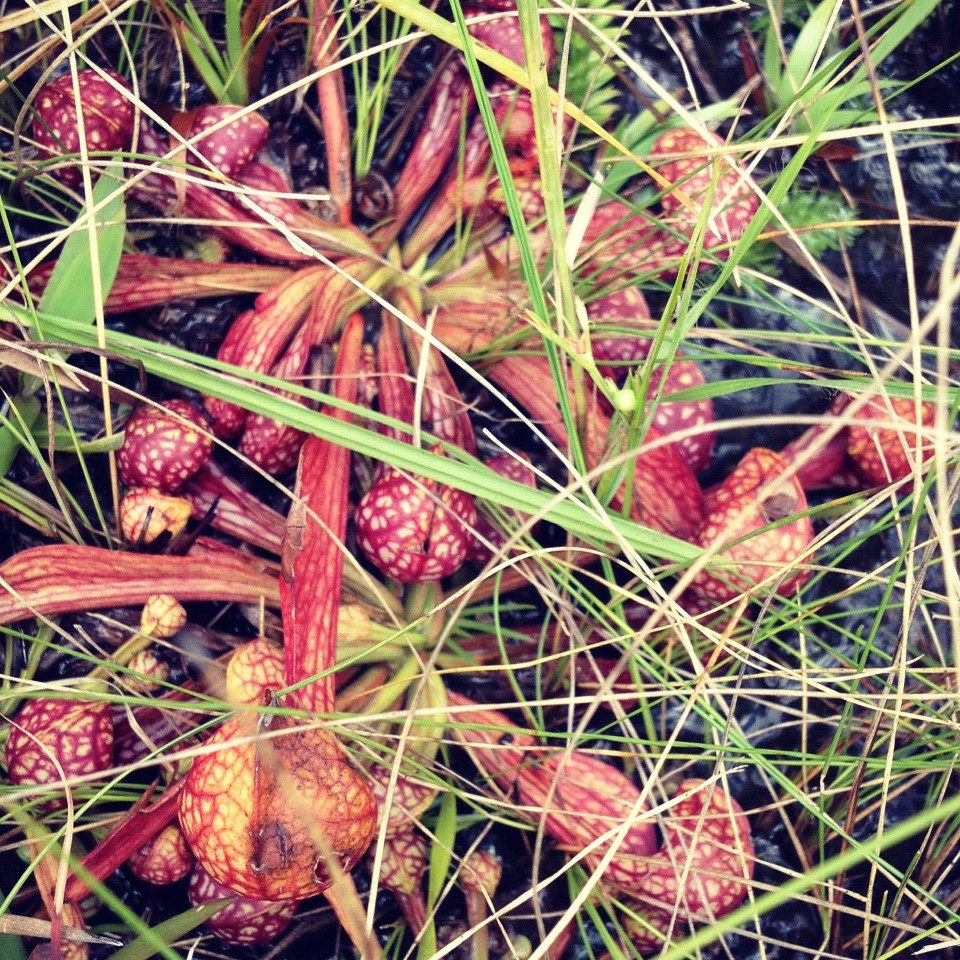
by Carrie Stevenson | Mar 29, 2016
Among the most fascinating natural phenomena in our area are the presence of dozens of species of carnivorous, or meat-eating, plants. Found in bogs, meadows, and seepage slopes with mucky, acidic soils and low levels of nutrients, these plants have adapted to their difficult conditions by developing ways to digest insects.These carnivores are best known by their common names; sundew, butterwort, bladderwort, and pitcher plants.
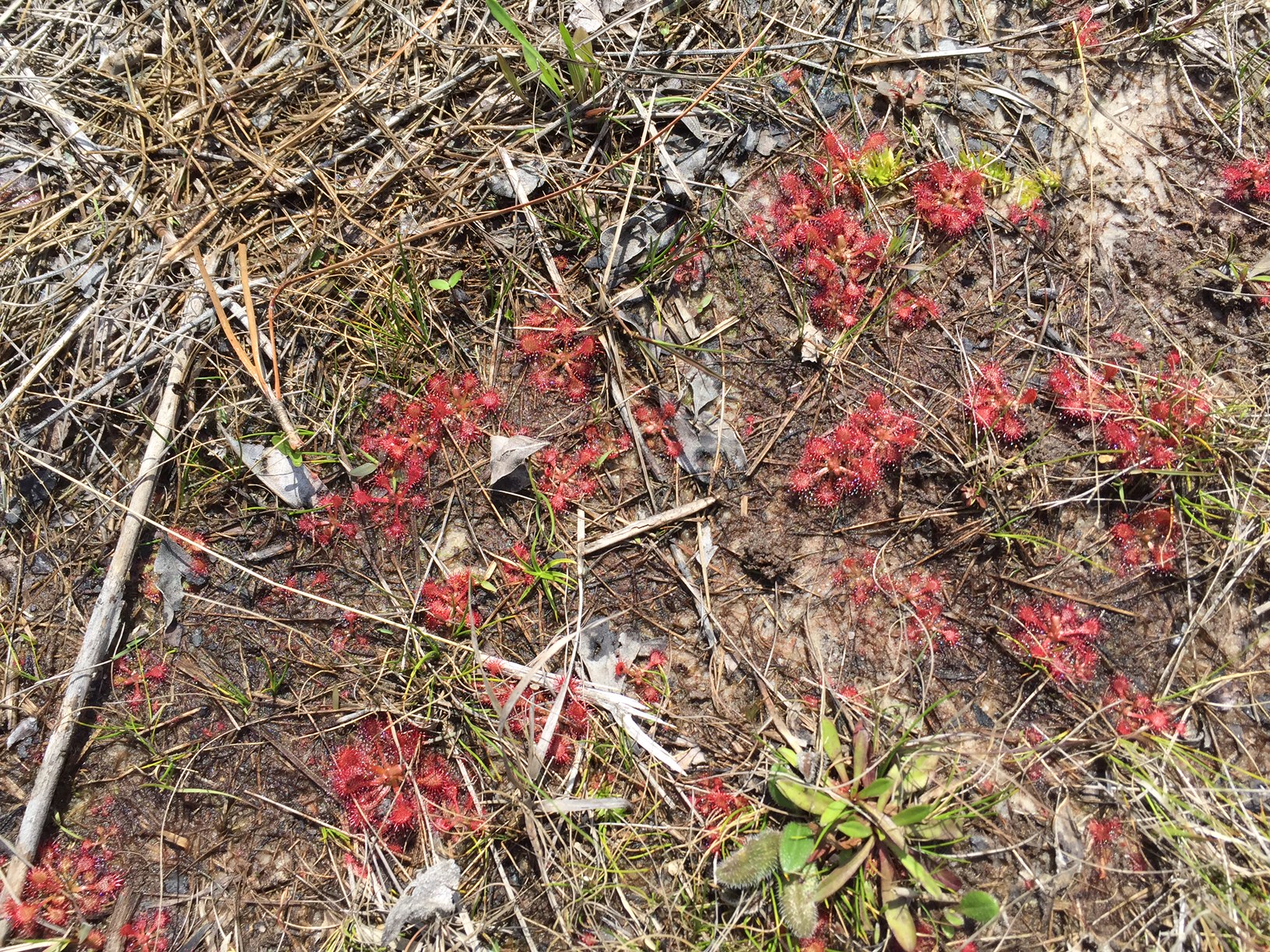
Sundew plants ready to feast
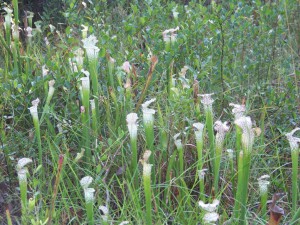
A meadow of white-topped pitcher plants in full spring bloom.
While there are six species of pitcher plants found in the panhandle and throughout the Gulf Coastal Plain, the “world’s largest concentration” can be found at Escambia County’s Tarkiln Bayou Preserve State Park. The “pitcher” part of the plant is actually a modified leaf, which is rounded into a hollow tube open at the top and partially covered by a hood. This hood is colorfully patterned, attracting insects also drawn to nectar inside the tubes. As insects crawl in, downward-facing hairs prevent them from escaping. They drown in the collected water within the tubes, then decompose via acids and enyzymes secreted by the plant into a “liquid fertilizer.” A handful of commensal animals, including flies, spiders, and small frogs, take advantage of the pitcher plants’ insect-trapping expertise and manage to avoid capture.
A guide to identifying all six of these pitcher plant species–white-top, parrot, trumpet-leaf, hooded, sweet, and yellow–can be found at the Florida Department of Environmental Protection’s wetland plant site. Now is the perfect time to see pitcher plants beginning to blossom.
While many people are familiar with pitcher plants, fewer notice the low-growing sundew. These plants may be smaller than a dime in circumference, and grow flat along very mucky soil in full sun. If shaded out even by relatively short grasses, sundew disappear. Their characteristic pinwheel-like appearance and deep red coloring help draw the eye if you look very closely. Sundews also excrete a sticky nectar, on which small insects get stuck and digested to provide nutrients to the plants.The leaves of butterwort plants work very similarly to sundews; they are typically bright green and succulent with sticky hairs that attract nutrients.
Bladderworts, also found in similar environments, use a different mechanism to trap insects. They actually have a bladder-like formation within their root system that opens and closes, siphoning water and unlucky insects in and out.
Regardless of their location, appearance, or method of trapping, carnivorous plants remain one of the most unusual, and interesting groups within the plant kingdom. Be sure to take the opportunity this spring to seek out a park or natural area populated with carnivorous plants–such as Tarkiln, Blackwater River State Park, or the public areas of Eglin Air Force Base and see them for yourself!
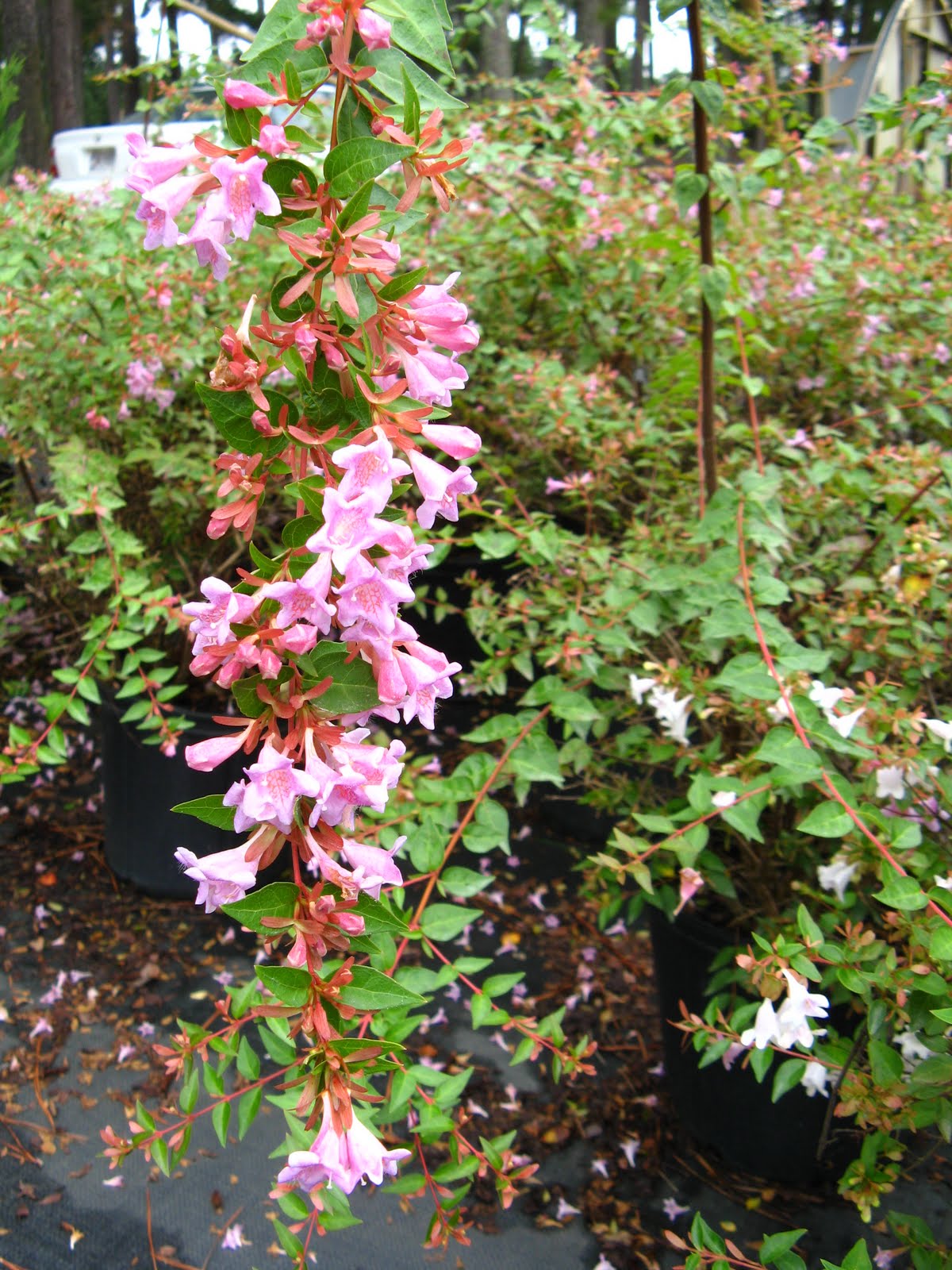
by Julie McConnell | Mar 28, 2016
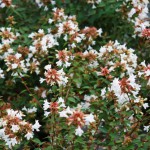
Clusters of tiny white flowers on abelia. Photo: Julie McConnell, UF/IFAS
Abelias have been a landscape staple in the Southeastern United States for over a century. Numerous types have been used over the years, but two of the oldest forms still used in landscapes are Glossy Abelia Abelia x grandiflora and Abelia ‘Edward Goucher’, dating back to the early 1900s.
Glossy Abelia is a large informal shaped shrub with ½ – 1 inch glossy green leaves and large clusters of tiny white flowers. It can grow to 8 feet wide and tall and tolerates tough landscape sites such as full sun, low moisture (once established), acidic or slightly alkaline soils. It blooms prolifically and is attractive to butterflies and pollinators. New stems are reddish colored which contrasts nicely with dark green foliage which may be evergreen if winters are mild. After blooms are spent the pink sepals remain on the plants carrying more color through the season.
‘Edward Goucher’ Abelia does not grow quite as large and is a good performer with pink flowers. It is smaller than Glossy Abelia, but can still reach 5’x5’ when mature. It is also tolerant of hot, dry spots in the landscape.
Over the past few decades there have been many new introductions of abelia cultivars to the market. A major goal of breeders was to offer abelias that would fit into smaller landscapes and there has also been a trend towards variegated foliage color. There are dozens of abelias in production, but a few listed below are usually easy to find in local garden centers and have proven reliable in Florida landscapes.
- Abelia x ‘Rose Creek’ Rose Creek Abelia, low mounding growth habit reaching 2-3’ tall and 3-4’ wide, green foliage, new reddish stems, large clusters of white flowers
- Abelia x grandiflora ‘Hopley’s Lemon Zest™’ Lemon Zest Abelia or Miss Lemon™ Abelia grows 3-4’ tall and wide, has yellow and green variegated foliage, light pink flowers
- Abelia x grandiflora ‘Confetti’ Confetti® Abelia, matures at 3’ tall and wide, new foliage has pink, white, and green variegation and mature foliage is green and white variegated, pink and white flowers
- Abelia x grandiflora ‘Kaleidoscope’ P.P.#16,988 Kaleidoscope Abelia, compact growth 2-3’ tall by 3-3.5’ wide, gold and pink new foliage that matures into gold and green variegation, white flowers
All abelias perform best in full sun to part shade and have low water requirements once established. They are not salt tolerant, so avoid planting in coastal landscapes or in areas where salts are an issue. Abelias have few pest problems, but aphids have been known to feed on new growth – avoid over fertilization.
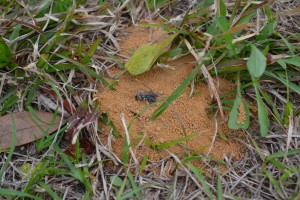
by Beth Bolles | Mar 28, 2016
The mining bees or adrenids are often seen in areas of landscapes that have little ground vegetation and loose soil. After mating, the female bee will excavate a very small tunnel in the ground that has several small cells attached to it.
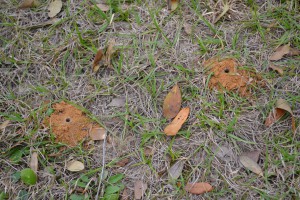
Beneficial solitary bee mounds in the ground. Photo by Beth Bolles
The bee collects pollen and nectar to add to the cell and then lays a single egg in each cell. The emerging larvae feed on the nectar and pollen until it changes to an adult bee in the fall. There is only one generation a year. Although these solitary bees individually produce small nests, sometimes many will nest in close proximity to each other.
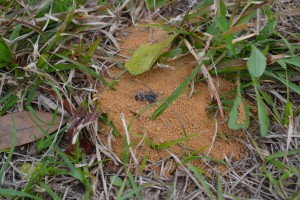
Solitary bee entering ground. Photo by Beth Bolles
Solitary bees are not aggressive and stings are quite mild. Most solitary bees can be closely observed and will elicit no defensive behaviors. Perhaps the most common stings that occur are when the sweat bee, which is attracted to moisture, stings when swatted. Males of some solitary bees, which can not sting, will sometimes make aggressive-looking bluffing flights when defending a territory.
Like the most famous honey bee, solitary bees play a beneficial role in the pollination of plants. Their activity in the spring is short-lived and no management is necessary.
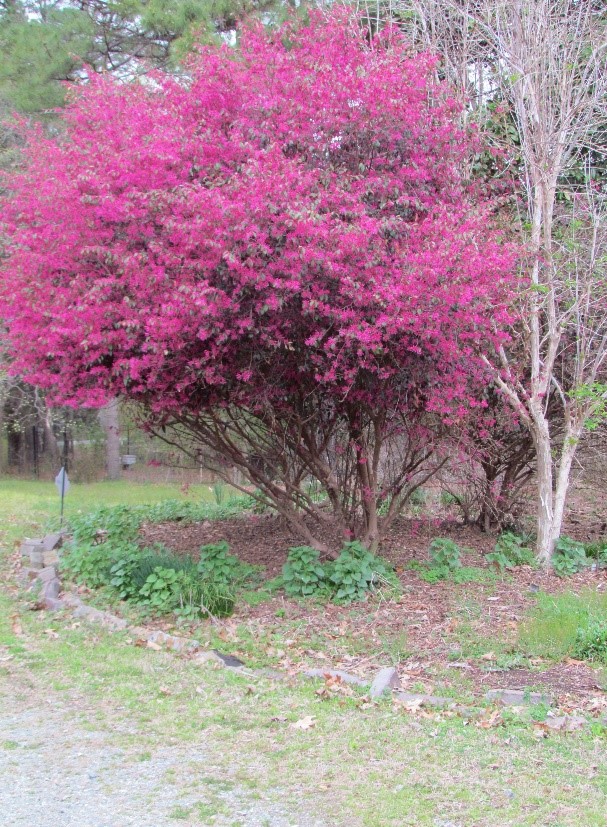
by Daniel J. Leonard | Mar 23, 2016
One of the major issues homeowners face in their landscapes is selecting a tree that in maturity will be in scale with the rest of their garden and home. While we have several actual trees that fit the bill, I would like to focus today on thinking outside the box by selecting a larger growing shrub that we can “limb up” into a small tree!
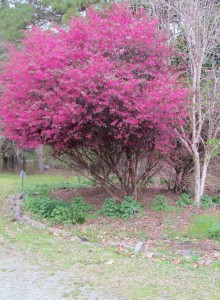
Loropetalum in its tree form
Today’s plant is Loropetalum chinense, also known as Chinese Fringe Flower, a beautiful import related to our native Witchazels (Hammemelis spp.). Some species of Loropetalum can have green foliage and white flowers, but it is generally found in its coveted maroon-foliaged form, which is the subject of this piece. Most cultivars of Loropetalum (with the exception of a few newer ‘dwarf’ cultivars) are large (to 20’ tall and about half as wide) evergreen shrubs that prefer partial shade to full sun. In the early spring, it bursts with wavy, fringe-like red, pink, or white flowers!
In order to “tree-form” the plant, one should gradually begin removing lower lateral branches, crossing or rubbing branches, and any potentially diseased branches, leaving 5-7 main trunks. Eventually, most common cultivars of Loropetalum can easily be pruned to have 4’-5’ of exposed trunk!
Unfortunately, Loropetalum has been both overused and misused as a tightly sheared foundation plant in every landscape imaginable, from gas stations to Aunt Gertie’s rental house. As such, it has gotten a bad reputation as a monster that has to be constantly sheared to keep it in line. This reputation is completely unwarranted if using the shrub as it was meant to be used, as a large specimen shrub or a graceful small-tree! Yet another example of how using the right plant in the right place can change the public’s entire perception of it! Try tree-forming a Loropetalum today and enjoy it for years to come! Happy Gardening!
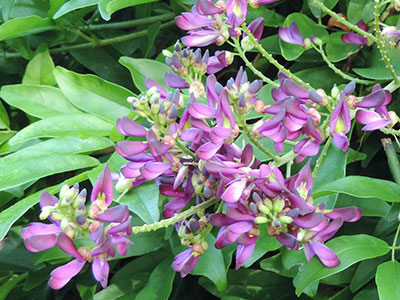
by Matt Lollar | Mar 22, 2016
Are you looking for a way to jazz up a fence, trellis, or arbor? Are you looking for year-round color in your garden? Are you looking for wonderful, fragrant blooms in the summer? Than evergreen wisteria (Millettia reticulata) may be the right plant for your place!
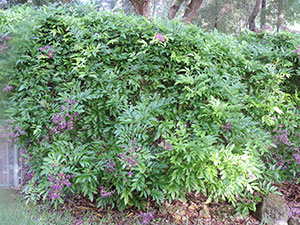
Evergreen wisteria growing on a fence. Photo: University of Florida/IFAS
Evergreen wisteria is not only a beautiful vine, but it is an excellent alternative to that pesky, invasive Chinese wisteria. Sometimes referred to as summer wisteria, this plant is native to China and Taiwan. As you may have noticed by its scientific name, Millettia reticulata, is not a true wisteria but it is in the same plant family, Legumaceae or the bean family.

Evergreen wisteria in bloom. Credit: University of Florida/IFAS
Evergreen wisteria is a woody vine that has glossy, thick green leaves and clusters of small, fragrant, purple flowers. The plant can reach a height of up to 30 feet, but can easily be controlled with pruning. It blooms in the summer, and often into the fall, with deep purple, pea shaped blooms. Although its common name states it is evergreen, it is often semi-evergreen in the Panhandle. Evergreen wisteria grows best in full sun, but can tolerate partial shade.
Evergreen wisteria can tolerate a wide range of soil pH as long as the soil is well-drained. It is a twining vine and may need a little help to start growing on a structure. It can be left alone to climb tall structures like pergolas and arbors, but you may want to selectively prune the plant to encourage it to leaf out at its base when training on a trellis or fence. Deadheading (removing spent blooms) will encourage an elongated bloom season.
Evergreen wisteria can help add an additional visual dimension to your landscape and it won’t invade your space like its distant cousin.












